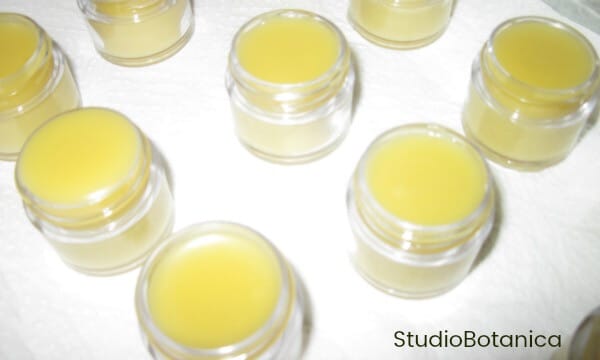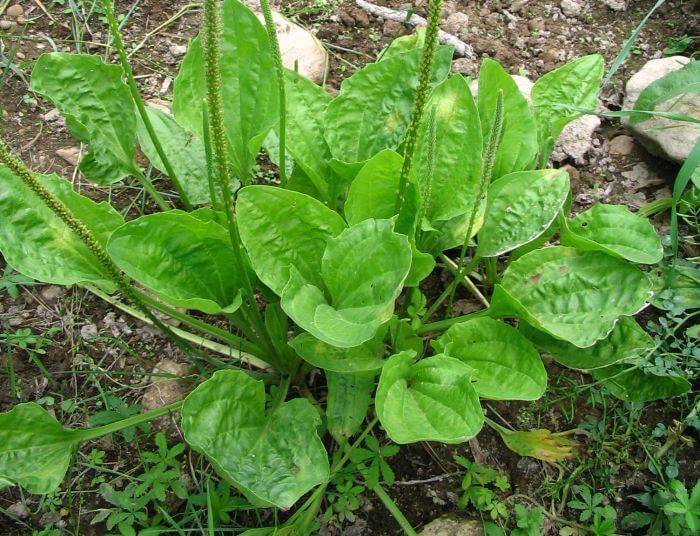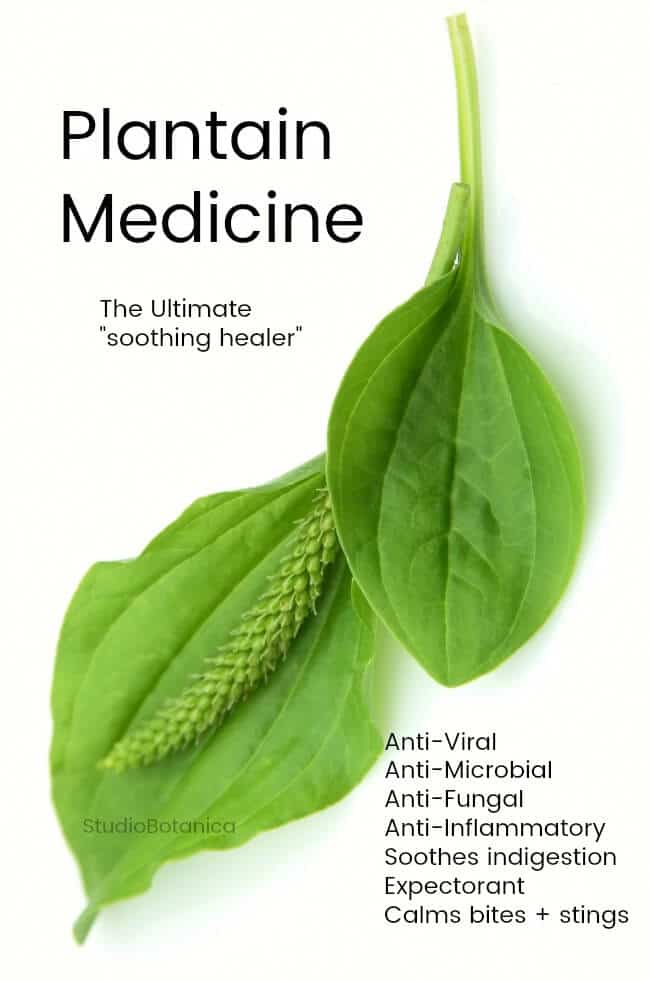I have a special fondness for plantain. I guess, this gentle green ally, was my "ah ha moment" and introduction to herbal medicine! Plantain medicine.. in fact..
I was out for a walk in the countryside with some friends; a rather informal weed-walk, I remember. We came upon a marshy area and suddenly I was swatting at several dive-bombing insects. I have always said that I’m a mosquito magnet and I was, indeed, that day.
At one point in the next hour, sporting 5 or 6 itchy bites, I was a little distracted from our sunny day. One of the members of our group, a savvy plant person, told me she had an idea. Suddenly she dropped down onto one knee and picked some leaves, which she then presented to me with a twinkle in her eyes.
“Pop ‘em in your mouth and chew ‘em up”, she directed. I gave her a puzzled look and blurted “why am I doing that?” She told me to trust her and trust that this was the plant for me. So I did. What happened next I have never forgotten. She had, of course, found some plantain leaves and picked them for what I would come to understand is a “spit poultice’. Plantain tastes ‘green’. It’s quite mucilaginous after a short while but not unpleasant. After a few minutes, I was instructed to take the ‘green wad’ out of my mouth and apply it to one of my itchy bites. What happened next was a total surprise!
After less than a minute, the itchy bite stopped being itchy. This may seem like a tiny event. For me, however, it was huge. I quickly learned to identify plantain, under our feet, and made another ‘green wad’, repeated the process with the same results! I was so excited. This was a true “a – ha “ moment in my life. I was inspired, on the spot, to learn more. I’ve never looked back.
Do you have a story about an herb that "woke you up to the magic of the plant world?”
There are actually two 'major' species of plantain that grow in our area: lance-leaved plantain (Plantago lanceolata) and broad-leaved plantain (Plantago major, in picture above). They can be used interchangeably. All parts of the plant, including the seeds, are edible. There are actually 34 species of plantain! (all are edible and medicinal).
Plantain Medicine Highlights
- high in calcium
- contains silica ~ benefits skin, nails + important for re-mineralization of teeth
- antibacterial
- astringent
- antiseptic
- antimicrobial
- anti-inflammatory
- anti-viral
- anti-fungal
Since that first encounter, I’ve learned that plantain possesses many healing attributes. It offers so much in the area of ‘first aid’ applications, so in the Spirit of that first ‘mind-opening’ experience, here are a few ideas describing how I use this green ally:
As an anti-microbial and anti-inflammatory, plantain can take the pain, itch, and swelling from insect bites, bee stings, animal bites, minor scratches and even poison ivy! It acts quickly to heal + soothe bruises, cuts and minor abrasions.
Plantain leaf ‘spit poultice’ is my ‘go-to remedy’ to help to draw out splinters or remove tiny shards of glass embedded in a finger. This ‘drawing action’ is quite powerful, as plantain is also known as the plant in an emergency to use in cases of blood poisoning.
I remember a story from years ago from a friend enjoying a mountain hike who offered the healing touch of plantain to her companion with a nasty snakebite. She recounted the amazement and sheer relief they felt when that menacing red line steadily receded back down her friend’s arm, allowing them time to get medical attention.
Digestive System Support
Make an infusion with plantain leaves to relieve tummy upsets
A cup of plantain tea from fresh or dried leaves will soothe heartburn, IBS symptoms and indigestion. It can also be helpful in situations of urinary tract infections, as well as bladder and kidney infections.
Anti-Inflammatory Help
We use plantain in the treatment of ulcers and other inflammatory conditions of the digestive tract.
Lymphatic System support
Plantain can be very helpful in for lymphatic conditions due to the anti-inflammatory + 'drawing action' (described above!)
Expectorant
Plantain is a relaxing and mucilaginous expectorant. Great for irritated coughs. In adults, it must be combined with stronger expectorants. It IS good for children.
I sometimes combine it with thyme, and will add a formula asap.. here..
With ‘first aid’ in mind, I like to make a few concoctions to have on hand in case of bites, stings, splinters etc or even summer canker sores, upset stomach or sore throats. We can make this spray, and the same 'tea' makes a wonderful eye wash. Got some sand or dust in that eye? Make this tea and flush or lightly rinse the affected eye with this infusion!
First Aid Spray
I make a long infusion of plantain in (just boiled) hot water, “plantain tea”.
I let it steep overnight, and strain it. It goes immediately into spray bottles, which I keep handy for soothing sunburns. A small atomizer bottle is a part of my summer ‘on the go’ first aid kit. Store in fridge and use within 3-4 days. I sometimes make a couple of extra bottles to freeze. Just leave a little space in the bottle so it freezes well.
Plantain tea is also a good remedy to soothe canker sores or other sores in the mouth as well as being a readily available sore throat remedy. I’ve made a tea with plantain ‘out on the trail’, with good results. Keep it in mind also, in cases of upset stomach or sudden digestive disturbances.
Soothing and 'pulling' or 'drawing' are key words with plantain.
Vinegar Spray:
I make a vinegar infusion, using good quality apple cider vinegar. I keep the plantain in the vinegar for about a month. After straining it, I make use of small spray bottles again and use this remedy also to soothe the pain and heat of sunburn, and also find that this infused vinegar is quite effective in cases of poison ivy. I typically infuse jewelweed (Impatiens spp) in apple cider vinegar and alternate plantain and jewelweed to soothe this most irritating of summer situations.
Plantain Medicine ~ soothing salve
Probably my favourite way to ensure that plantain is available at all times – and for those moments when a spit poultice is not possible,(or socially acceptable!) is the creation of plantain salve via the making of a nice big deep green jar of infused oil of plantain made with olive oil. Plantain salve is legendary for the ability to soothe and heal and nourish our skin.
Salves are easy to make. We need to start with an oil infusion of plantain leaves.
Plantain Medicine:
Here’s how to make an infused oil with plantain leaves:
Locate local plantain.
Harvest the leaves.
Allow to wilt for a few hours (or sometimes I allow to dry completely)
Fill a clean glass jar with the leaves
Add good quality olive oil to cover the leaves
Use a chopstick (or other non metal utensil) to poke the leaves gently to release air bubbles.
Place a lid on the jar
Label with contents and date.
It’s not necessary but can be helpful to use a chopstick or bamboo skewer over the next week to poke the plant material and move around a bit, to ensure air bubbles continue to release.
The oil is infused after about 4 weeks. I have oil in my cupboard that has been infusing for months (confession!)
Strain the oil through a few layers of cheesecloth or a nut milk bag into another clean glass container.
Label and date this 2nd jar. “Infused Plantain in Olive Oil”
This is how I make infused oils. I prefer to plan ahead and infuse without heat. There are other methods. I will write about these methods and link back here soon.
Plantain Medicine:
make your own soothing plantain salve with infused olive oil
- 1 cup of plantain infused olive oil
- 1 oz beeswax
- optional: essential oils (e.g. lavender, orange)
Put the beeswax into a glass measuring cup and make a sort of ‘bain marie’ by
placing the measuring cup in a pot of simmering water.
You can also use a small glass bowl and place it above the water to allow wax to melt.
Add the infused plantain oil to the melted beeswax.
Mix well with a non-metal utensil and allow to cool a little.
If using essential oils, add in a 4-5 drops of your essential oil.
Pour into a clean glass jar or small glass pots, and allow to cool further.
I always reserve a little of the oil to top up the salves when almost ‘set’.
The salves often develop a wee 'dimple' when it begins to harden.
If you have a little warm oil mixture on hand, it finishes it off beautifully.
Add the lids later, after the salve is at room temperature.
Here’s to a “soothing”, fun-filled, healthy and ‘boo boo’ –free time for all! ox Carol
p.s
For my complete 'mega list' and for the sake of completeness, here are my notes from classes at the Living Earth School Traditional Herbalist programme:
Primary Properties: Anticatarrhal, anti-inflammatory, astringent, demulcent, depurative, diuretic, lymphatic, vulnerary.
Secondary Properties: Antiallergenic, antibacterial, antineoplastic, antispasmodic, antiulcerogenic, aperient, bitter, bronchodilator, cholagogue, expectorant (relaxing), hemostatic/styptic, hypocholesterolemic, hypolipidemic, immune stimulant, vascular tonic.
See glossary here for any terms or email me with any questions!
We can all feel better -- with this delightful soothing herb!
Often called a common weed - it's plentiful and easy to add to our lives!




Beth
I had a planters wart on my foot that just wouldn't go away. The doctor tried to freeze it twice to no avail. A friend told me about plantain leaves and I tried them. I soaked my poor foot (which now had numerous baby planters warts) in plantain boiled water and then made a poultice and applied it with a bandage. It took a bit as I had them for quite awhile but they totally cleared the whole of them. I tell people about them all the time!
Carol Little R.H.
Thanks for sharing Beth!! PLANTAIN MEDICINE !!!!
Laura Duffy
I've heard about "plantain poultice" from one of my local edibles classes. It is fascinating! We have lots of plantain growing in our area. I'm excited to know the other things it can do!
Carol Little
Plantain is a wonderful herbal ally to know-- all in the same plant: anti-viral, anti-bacterial, anti-fungal.. MAGIC!!
linda spiker
As always I learned so much. I really knew nothing abour plantains before reading this. That salve is so pretty I want to eat it lol.
Carol Little
Thanks Linda. It is my passion to share the magic of our green world and yes.. it IS pretty. You could eat it
but I've got an edible plantain recipe for you.. Will organize that one.. and send!
Trudy Rohler
Back in the mid 1940's, as a child I fell and cut my hand and didn't tell anyone about it. When it got infected a couple of days later I had to tell my parents. My dad took one look at the wound and went out in the yard and picked several plantain leaves brought them into the house, washed them off and smuched them up to make some juice out of them and put them on my wound and put a bandage on it and by golly the next day my sore was so much better and almost healed. I have been a plantain believer ever since then.
Carol Little
Trudy, thanks so much for sharing! Yes, your story echoes many in my own life and rings true! Yay PLANTAIN!!
Renee D Kohley
I knew plantain was for a wounds and we use it right out of our yard for that - but i had no idea it did so much more! Cool!
Carol Little
Renee, so glad that you already use that way.. Yes.. dry some and infuse for a delightfully powerful salve!